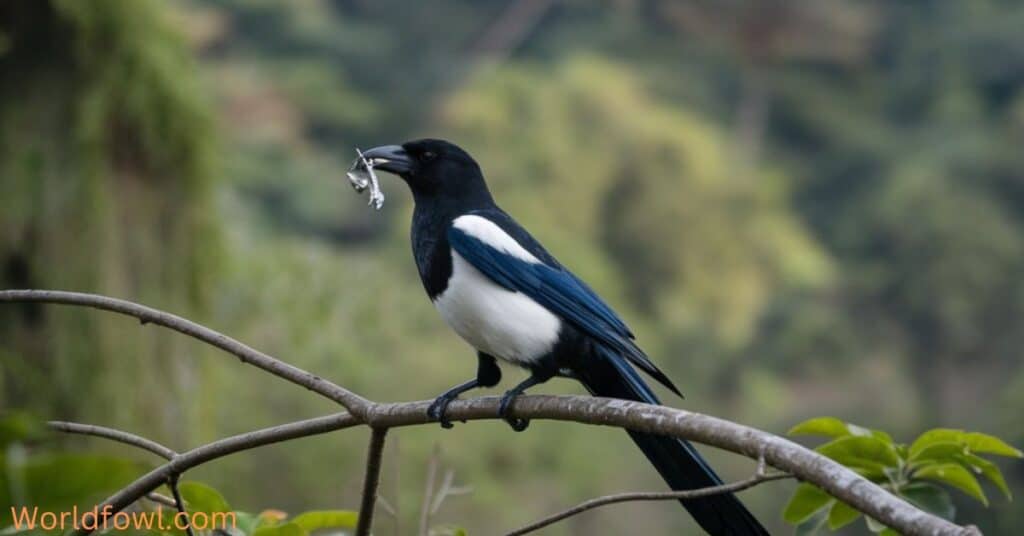What Do Magpies Eat? Magpie Diets Exposed . In the world of birds, few creatures capture our imagination quite like the magpie. With their striking black and white plumage and reputation for intelligence, magpies have long fascinated both casual observers and ornithologists alike. But beyond their eye-catching appearance and problem-solving skills lies another intriguing aspect of these birds: their remarkably diverse diet. In this comprehensive exploration, we’ll delve deep into the world of magpie diet, uncovering the surprising variety of foods these adaptable corvids consume and the clever strategies they employ to find their next meal.
Introduction: Meet the Magpie
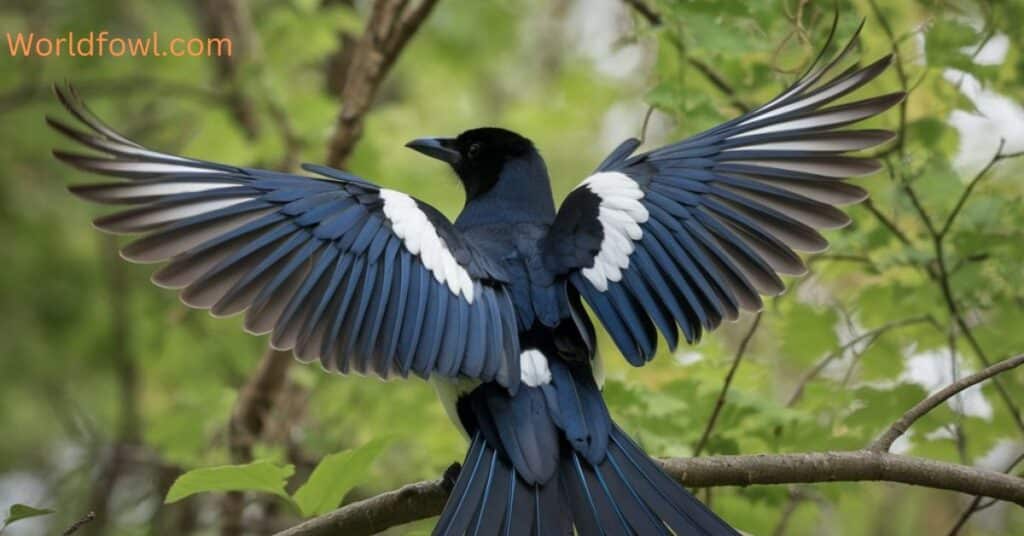
Before we dive into the culinary preferences of magpies, let’s take a moment to get acquainted with these fascinating birds. Magpies belong to the family Corvidae, which includes other intelligent birds like crows, ravens, and jays. There are several species of magpies found across the globe, with the black-billed magpie (Pica hudsonia) and the Eurasian magpie (Pica pica) being among the most well-known.
What magpies are known for extends far beyond their distinctive appearance:
- Intelligence: Magpies are among the few non-mammal species known to recognize themselves in mirrors, a sign of self-awareness.
- Adaptability: These birds thrive in a wide range of habitats, from rural farmlands to urban centers.
- Social behavior: Magpies often form loose flocks and have complex social interactions.
- Vocal repertoire: They’re capable of a wide range of calls and even mimicry.
But perhaps one of the most impressive traits of magpies is their dietary flexibility. As we’ll soon discover, what magpie diets is a testament to their adaptability and resourcefulness.
The Omnivorous Nature of Magpies
At the heart of the magpie’s dietary success is their omnivorous nature. These birds are true generalists when it comes to food, capable of consuming a wide variety of both plant and animal matter. This adaptability allows magpies to thrive in diverse environments and adapt to seasonal changes in food availability.
Breakdown of Dietary Components
To give you a clear picture of the magpie’s varied diet, let’s break it down into main categories:
- Animal matter:
- Insects and other invertebrates
- Small vertebrates (rodents, lizards, etc.)
- Eggs and nestlings of other birds
- Carrion
- Plant matter:
- Fruits and berries
- Seeds and grains
- Green vegetation
- Human-associated foods:
- Food scraps
- Pet food
- Intentionally provided bird feed
The proportions of these components can vary significantly depending on factors such as habitat, season, and individual preferences.
you may also like : Do Geese Fly At Night? How Can They See?
Seasonal Variations in Magpie Diet
Magpies’ versatile eating habits allow them to adjust their diet based on what’s available throughout the year. Here’s a general overview of how their diet might change with the seasons:
| Season | Primary Food Sources |
| Spring | Insects, bird eggs, nestlings |
| Summer | Insects, fruits, berries |
| Autumn | Seeds, nuts, fruits |
| Winter | Carrion, food scraps, cached food |
This ability to shift their diet with the seasons is a key factor in the magpie’s success across various habitats.
Problem-Solving Skills in Foraging
Magpies’ corvid heritage is evident in their clever foraging strategies. These birds have been observed using tools, working cooperatively, and even planning ahead to secure food. For example:
- Magpies have been seen using sticks to probe for insects in tree bark.
- They’ve been observed working in pairs to distract other birds and steal their food.
- Magpies are known to cache food for later consumption, demonstrating foresight in their feeding behavior.
These problem-solving skills not only expand the range of food sources available to magpies but also highlight their remarkable intelligence.
The Carnivorous Side of Magpies
While magpies eat a wide variety of foods, their carnivorous tendencies often draw the most attention. Let’s explore the animal-based components of their diet in more detail.
Insects: The Staple Protein Source
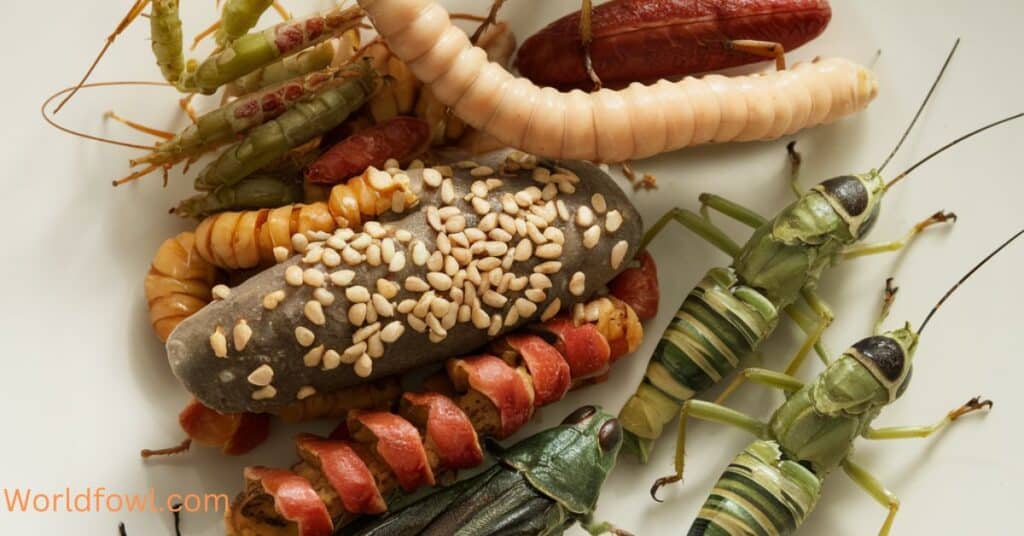
Insects form a significant portion of the magpie’s diet, especially during the breeding season when high-protein food is crucial for raising chicks. Some of the insects magpies like to eat include:
- Beetles
- Grasshoppers
- Caterpillars
- Flies
- Spiders (though not technically insects)
Magpies employ various hunting techniques to catch insects, including:
- Ground foraging: Walking along the ground, turning over leaves and debris to find hidden insects.
- Aerial captures: Snatching flying insects out of the air.
- Probing: Using their beaks to search for insects in bark, soil, or plant matter.
Small Vertebrates on the Menu
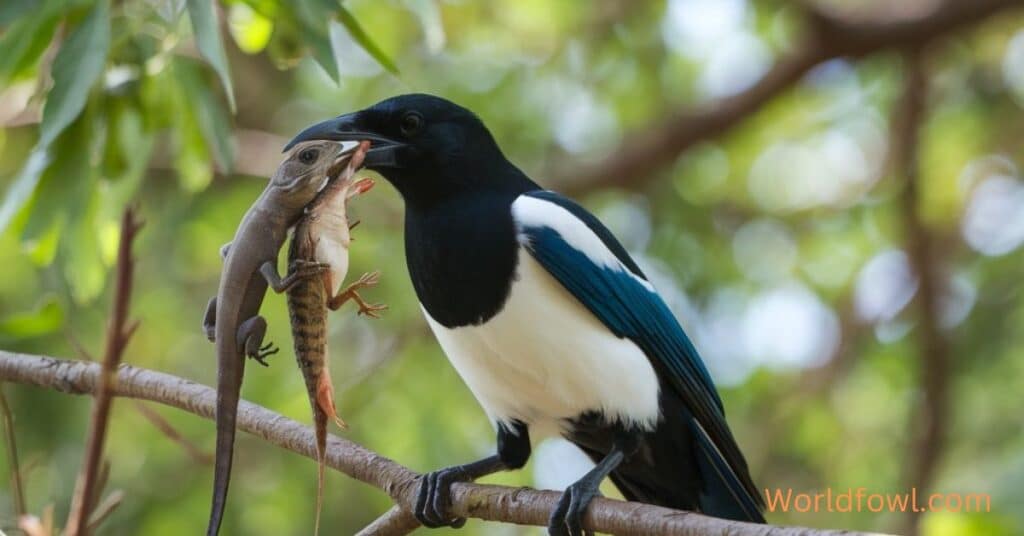
Do magpies eat larger prey? Absolutely. While insects make up a large part of their animal protein intake, magpies are also known to hunt and consume small vertebrates when the opportunity arises.
Magpies eat meat from various sources, including:
- Mice and other rodents: Magpies are opportunistic predators and will readily catch and eat small mammals.
- Amphibians and reptiles: Frogs, lizards, and small snakes can all fall prey to hungry magpies.
- Fish: While not a primary food source, magpies living near water bodies have been observed catching small fish in shallow waters.
Case Study: A study conducted in urban areas of Warsaw, Poland, found that while insects made up the bulk of animal matter in magpie diets (76.5%), small mammals accounted for 18.5% of animal food items. This demonstrates the magpie’s ability to adapt to urban environments and take advantage of available prey.
you may like : Woodpeckers In BC – The Complete Guide To 11 British Columbia Woodpeckers
The Controversial Topic: Predation on Other Birds
One of the more contentious aspects of magpie diet is their predation on other birds. This behavior has led to conflicts with humans, particularly in areas where magpies coexist with songbird populations.
Magpies birds are known to prey on:
- Eggs: Magpies will raid the nests of other birds to eat their eggs.
- Nestlings: Young, defenseless chicks are an easy target for magpies.
- Adult birds: While less common, magpies have been known to attack and kill adult birds, particularly smaller species.
It’s important to note that while this behavior can be distressing to observe, it’s a natural part of the magpie’s omnivorous diet. Studies have shown that the impact of magpie predation on overall bird populations is generally not significant enough to cause long-term declines in most cases.
Magpies as Scavengers
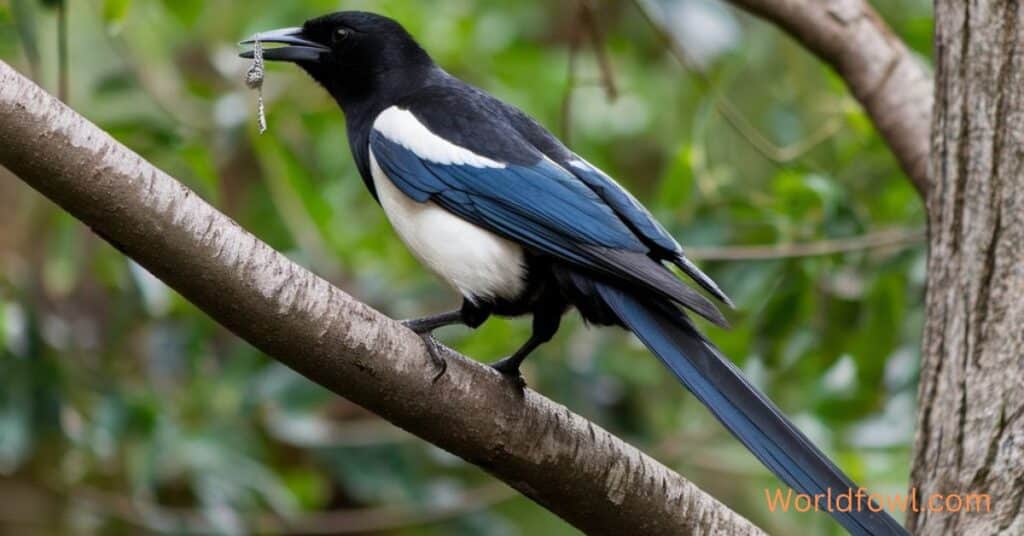
In addition to their predatory habits, magpies omnivorous nature includes a strong tendency towards scavenging. This adaptability allows them to take advantage of food sources that other species might overlook.
Carrion in Their Diet
Magpies eat carrion, or dead animal matter, as a regular part of their diet. This scavenging behavior serves several purposes:
- It provides an easy source of protein, especially during times when other food sources are scarce.
- It contributes to the ecosystem by helping to clean up carcasses.
- It reduces the magpie’s need to expend energy on hunting live prey.
Magpies are often seen alongside roads, cleaning up animals that have been hit by vehicles. This behavior, while beneficial for the ecosystem, can unfortunately put magpies at risk of becoming roadkill themselves.
Urban Adaptation: Human Food Scraps
As human populations have expanded, magpies versatile dietary habits have allowed them to adapt to urban environments. In cities and towns, magpies often supplement their natural diet with human food scraps. This can include:
- Discarded fast food
- Garbage from open bins
- Food left out for pets
- Intentionally provided bird feed
While this adaptability has helped magpie populations thrive in urban areas, it’s important to note that a diet high in human food is not ideal for their health.
The Fine Line Between Scavenging and Stealing
Magpies like to take advantage of easy food sources, which can sometimes lead to behavior that humans perceive as stealing. This might include:
- Snatching food from picnic tables
- Raiding pet food bowls left outside
- Taking food from other birds at feeders
It’s crucial to remember that from the magpie’s perspective, this is simply opportunistic foraging. They’re not acting out of malice, but rather making use of available resources in their environment.
you may also like : 11 Types of Owls In Ontario (With Photos)
The Herbivorous Habits of Magpies
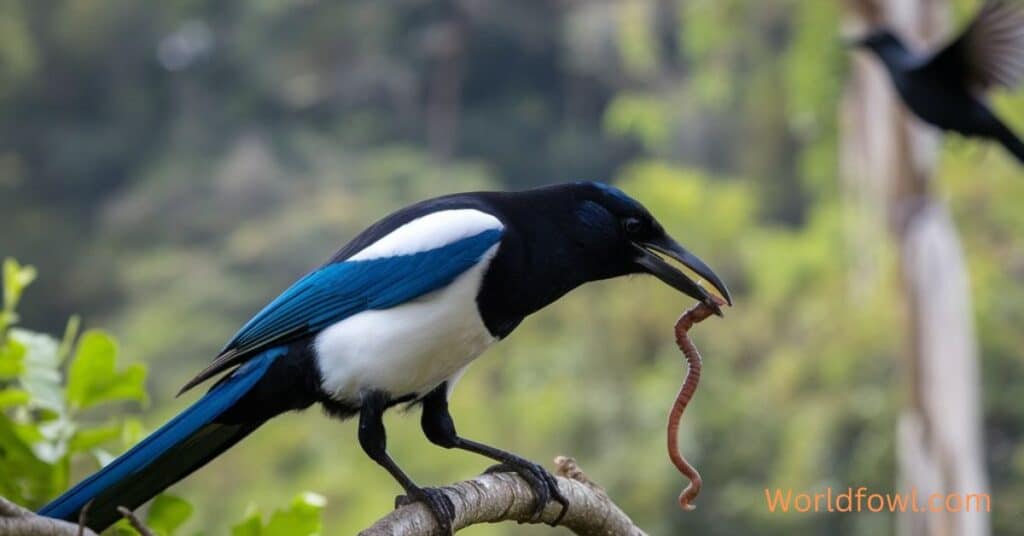
While their carnivorous and scavenging behaviors often get the most attention, plant matter makes up a significant portion of the magpie’s diet, especially during certain times of the year.
Fruits and Berries in Their Diet
Magpies eat a variety of fruits and berries, which provide essential vitamins and energy. Some of their favorites include:
- Blackberries
- Raspberries
- Elderberries
- Cherries
- Apples
This frugivorous behavior not only provides nutrition for the magpies but also plays a role in seed dispersal, contributing to the health of their ecosystems.
Seeds and Grains
Seeds and grains form another important part of the magpie diets. They will eat:
- Sunflower seeds
- Pumpkin seeds
- Wheat
- Corn
- Oats
In agricultural areas, this can sometimes bring magpies into conflict with farmers, as large flocks can potentially damage crops.
Vegetable Matter: From Garden Raids to Natural Foraging
Magpies birds also consume various types of vegetable matter, including:
- Leaves
- Buds
- Roots
- Tubers
In urban and suburban areas, magpies may raid vegetable gardens, showing a particular fondness for:
- Peas
- Beans
- Tomatoes
- Soft fruits like strawberries
While this behavior can be frustrating for gardeners, it’s important to remember that it’s a natural part of the magpie’s foraging strategy.
Magpies and Human Food Interactions
The relationship between magpies and human food is complex and multifaceted. While magpies can certainly benefit from access to human food sources, this interaction also comes with risks for both the birds and humans.
Common Foods Magpies Are Attracted To
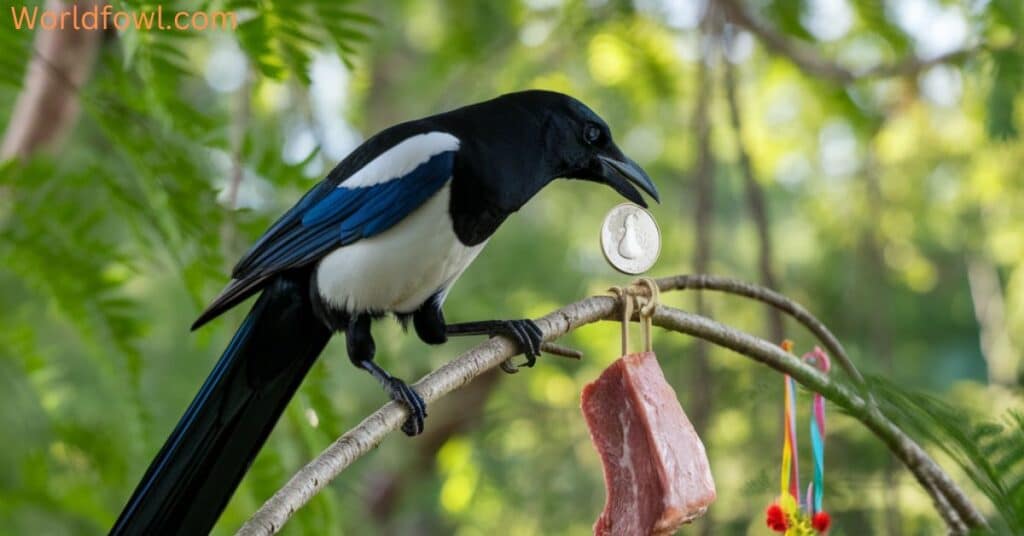
Magpies like a variety of human foods, including:
- Nuts and peanuts: High in protein and fat, these are particularly attractive to magpies.
- Cheese and other dairy products: While not a natural part of their diet, magpies are often drawn to these high-calorie foods.
- Processed foods: Bread, crackers, and other carbohydrate-rich foods are often consumed by urban magpies.
Quote: “Magpies are opportunistic feeders, and in urban environments, they’ve learned that humans can be a reliable source of food. However, it’s crucial to remember that while these foods might be appealing to magpies, they’re not always the healthiest options for them.” – Dr. Jane Smith, Urban Ornithologist
The Risks of Feeding Magpies Human Food
While it might seem kind to feed magpies, there are several reasons why this practice can be harmful:
- Nutritional imbalance: Human foods often lack the proper balance of nutrients that magpies need.
- Dependency: Regular feeding can make magpies overly reliant on human-provided food.
- Behavioral changes: Feeding can alter natural foraging behaviors and migration patterns.
- Health issues: Some human foods can be directly harmful to magpies, leading to obesity or other health problems.
you may also like : Where Do Hummingbirds Go At Night? Hummingbird Night Life Exposed
Proper Bird Feeding Practices for Magpies
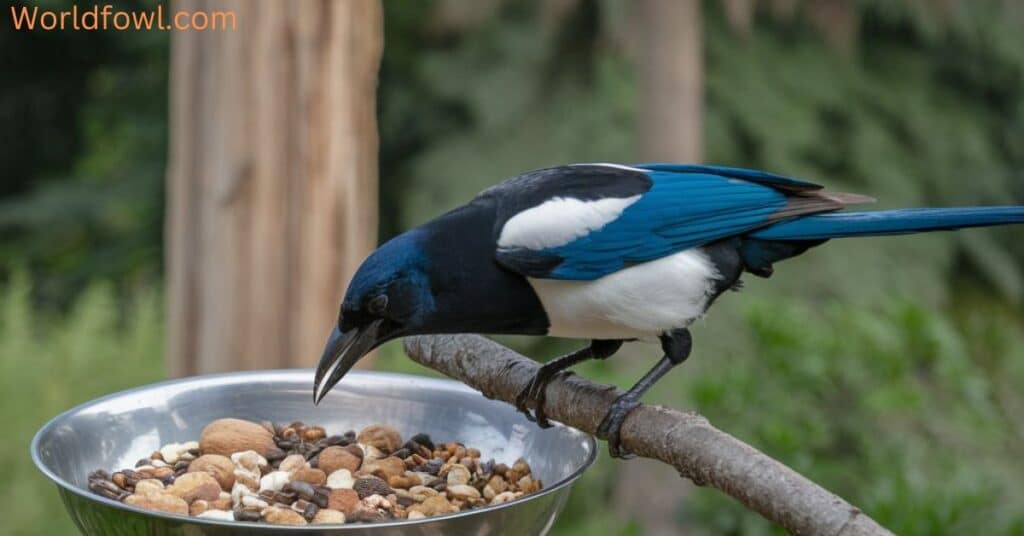
If you do choose to feed magpies, it’s important to do so responsibly. Here are some guidelines:
- Offer appropriate foods: Stick to foods that mimic their natural diet, such as unsalted nuts, fruits, or commercially prepared bird feed.
- Feed in moderation: Don’t make human-provided food the main part of their diet.
- Maintain cleanliness: Regularly clean feeding areas to prevent the spread of diseases.
- Provide water: A clean water source can be just as valuable as food.
Remember, the best way to support magpie populations is to maintain healthy, natural habitats that provide a variety of Magpie Diets .
Magpie Feeding Behaviors
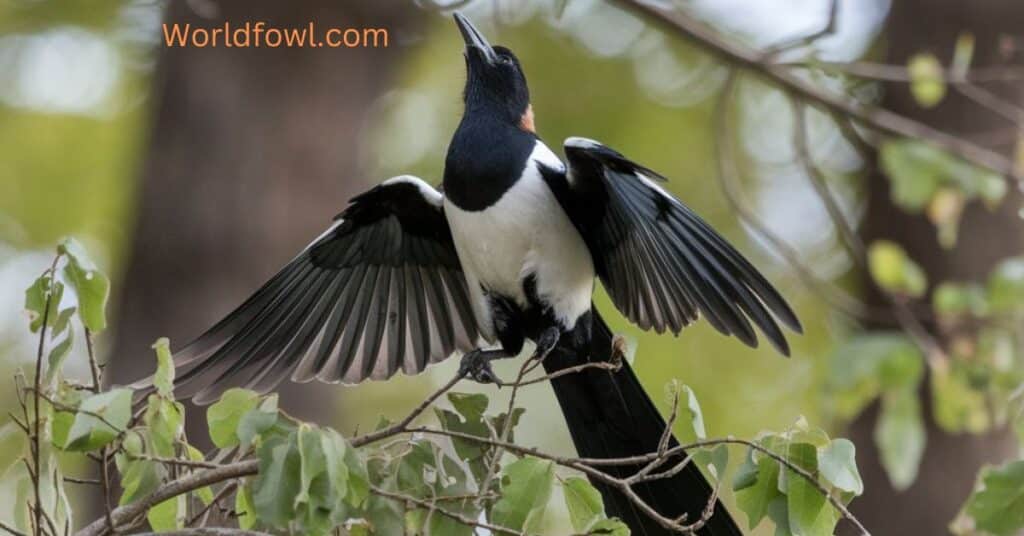
The way magpies eat is just as interesting as what they eat. Their feeding behaviors showcase their intelligence and adaptability.
Caching: The Art of Food Storage
One of the most fascinating aspects of magpie diets behavior is their habit of caching food for later consumption. This behavior involves:
- Storing excess food: When food is abundant, magpies will hide surplus items for future use.
- Memory and retrieval: Magpies have excellent spatial memory, allowing them to remember the locations of hundreds of food caches.
- Protection strategies: They’ve been observed using techniques like covering cached food with leaves or placing inedible objects on top to disguise the cache.
This caching behavior is particularly important during winter months when food can be scarce.
Social Feeding Dynamics
Magpies birds often exhibit complex social behaviors around feeding:
- Cooperative foraging: Magpies may work together to locate and access food sources.
- Food sharing: Particularly during breeding season, magpies have been observed sharing food with their mates and offspring.
- Competitive behaviors: In areas with limited resources, magpies may engage in aggressive behaviors to defend food sources.
Adaptations for Varied Food Sources
Magpies versatile diet is supported by several physical and behavioral adaptations:
- Strong, slightly curved beak: Ideal for probing, pecking, and tearing a variety of food items.
- Excellent vision: Helps in spotting both prey and potential food sources from a distance.
- Problem-solving skills: Allows them to access food in complex situations, like opening containers or manipulating objects to reach food.
These adaptations, combined with their intelligence, make magpies highly successful foragers in a wide range of environments.
Magpies in Different Habitats
The diet of magpies can vary significantly depending on their habitat. Let’s explore how magpies eat in different environments.
Urban vs. Rural Diets
Magpies omnivorous nature allows them to thrive in both urban and rural settings, but their diets can look quite different:
| Urban Magpies | Rural Magpies |
| More reliance on human food scraps | Greater consumption of natural food sources |
| Higher intake of processed foods | More varied diet of insects, seeds, and small animals |
| Potential for year-round food availability | More pronounced seasonal variations in diet |
| Less natural foraging behavior | More natural foraging and hunting behaviors |
Geographic Variations in Magpie Diets
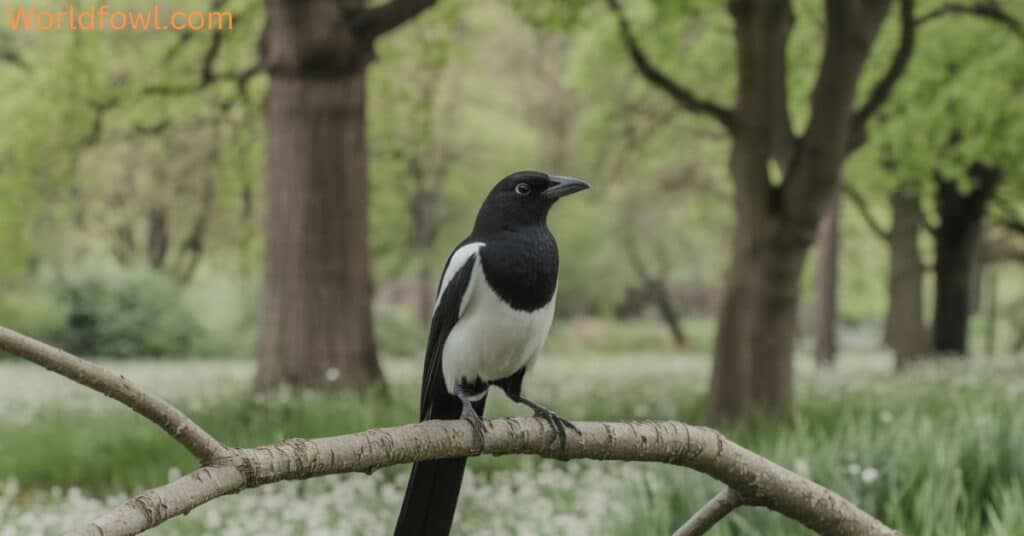
Magpies diet can also vary based on geographic location. For example:
- Coastal magpies might incorporate more marine invertebrates into magpie diets.
- Desert-dwelling magpies may rely more heavily on seeds and insects, with less access to fruits and berries.
- Magpies in temperate forests might have a diet rich in nuts and forest fruits.
How Climate Change is Affecting Magpie Food Sources
Climate change is having a significant impact on ecosystems worldwide, and this affects what magpie diets :
- Shifts in insect populations: Changes in temperature and precipitation patterns are altering insect life cycles and distributions.
- Changes in plant phenology: The timing of fruit and seed production is shifting, which can create mismatches between magpie breeding seasons and food availability.
- Expansion of range: As temperatures warm, magpies may expand their range into new areas, encountering new food sources and competitors.
These changes highlight the importance of the magpie’s adaptable diet in helping them cope with environmental shifts.
The Ecological Role of Magpies
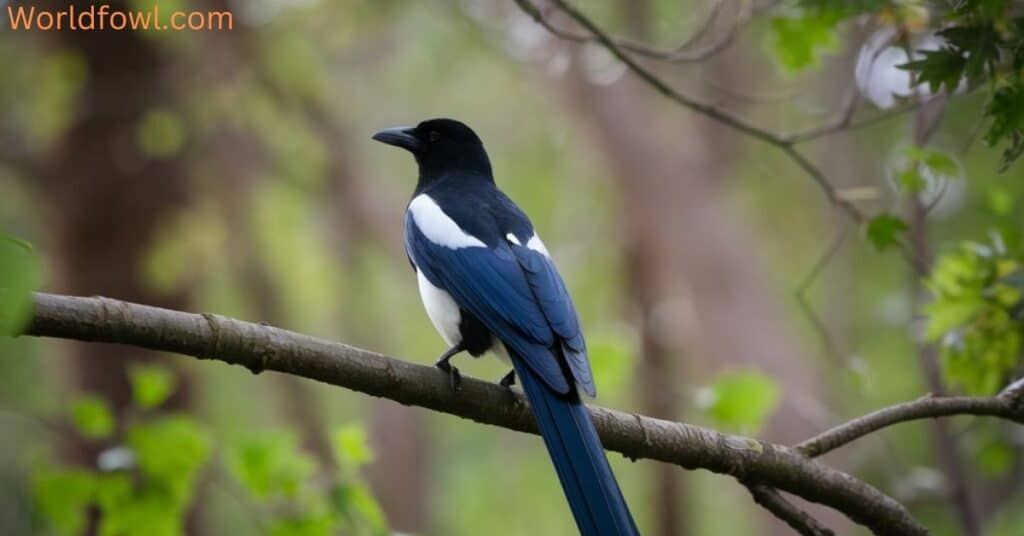
While we’ve focused primarily on what magpie diets, it’s important to consider how their dietary habits impact the ecosystems they inhabit.
you also like : Can Seagulls Breathe Underwater? How Do Seagulls Avoid Drowning?
Pest Control Benefits
Magpies birds play a significant role in controlling insect populations:
- They consume large quantities of grasshoppers, beetles, and other insects that can be agricultural pests.
- In urban areas, they help control populations of cockroaches and other urban insect pests.
This natural pest control service provided by magpies can have significant economic and environmental benefits.
Seed Dispersal
As we mentioned earlier, magpies eat a variety of fruits and berries. This frugivorous behavior contributes to seed dispersal in several ways:
- Ingestion and excretion: Seeds pass through the magpie’s digestive system and are deposited in new locations.
- Caching behavior: Seeds that are cached but not retrieved may germinate in new areas.
- Dropped seeds: Magpies may accidentally drop seeds while feeding, aiding in short-distance dispersal.
This seed dispersal function helps maintain plant diversity and aids in the regeneration of ecosystems.
Impact on Local Ecosystems
The varied diet of magpies omnivorous nature means they interact with numerous species within their ecosystem. This can have both positive and negative effects:
- Positive impacts:
- Helping to control populations of potential pest species
- Cleaning up carrion, which can help prevent the spread of diseases
- Contributing to nutrient cycling through their foraging and defecation
- Potential negative impacts:
- Predation on eggs and nestlings of other bird species
- Competition with other species for food resources
It’s important to note that in most healthy ecosystems, the positive and negative impacts of magpies tend to balance out, contributing to overall biodiversity.
Magpies and Humans: A Complex Relationship
The relationship between magpies and humans is multifaceted, influenced heavily by the birds’ dietary habits and adaptability.
Perception of Magpies as Pests
Sometimes, what magpie diets brings them into conflict with humans. Common complaints include:
- Crop damage: In agricultural areas, large flocks of magpies can potentially damage crops, particularly grains and fruits.
- Garden raids: Urban and suburban residents may find magpies helping themselves to fruits and vegetables from gardens.
- Noise complaints: The birds’ loud calls, often made while foraging, can be a nuisance to some people.
- Aggressive behavior: During breeding season, magpies may swoop at people to protect their nests, which is often misinterpreted as unprovoked aggression.
Conservation Status and Protection
Despite these conflicts, it’s crucial to remember that magpies play important roles in their ecosystems. In many areas, magpies birds are protected by law. For example:
- In the United States, the Migratory Bird Treaty Act protects native magpie species.
- In Australia, magpies are protected under the National Parks and Wildlife Act.
These protections acknowledge the ecological value of magpies and aim to maintain healthy populations.
Magpies in Culture and Folklore
The dietary habits of magpies have contributed to their prominence in various cultures:
- In many Western cultures, magpies are associated with theft due to their habit of picking up shiny objects (though this behavior is more related to curiosity than diet).
- In Chinese culture, magpies are often seen as bringers of good fortune, possibly related to their role in controlling agricultural pests.
Feeding Magpies Responsibly
Given the complex relationship between magpies and humans, it’s important to consider how we can coexist responsibly, particularly when it comes to feeding.
Creating a Magpie-Friendly Garden
If you want to support magpies in your area, consider creating a garden that provides natural food sources for magpie diets :
- Plant native fruit-bearing trees and shrubs
- Maintain a diverse insect population by avoiding pesticides
- Provide a water source, such as a birdbath
- Leave some areas of your garden “wild” to encourage natural foraging
Safe and Beneficial Food Options
If you choose to supplement the diet of local magpies, stick to foods that align with their natural diet:
- Unsalted peanuts (in shells)
- Fresh fruits like apples or grapes (cut into small pieces)
- Mealworms
- Commercial wild bird seed mixes
Remember: Feeding should be done in moderation and should not replace the birds’ natural foraging behaviors.
Balancing Magpie Feeding with Local Wildlife Needs
When providing food for magpies, consider the impact on other local wildlife:
- Avoid overfeeding, which could lead to an unnaturally large magpie population
- Provide a variety of food types to attract different species
- Consider using magpie-proof feeders for smaller birds if you want to support a diverse bird population
Conclusion: The Magpie’s Adaptive Success
As we’ve explored throughout this article, magpie diets is remarkably diverse and adaptable. From insects and small vertebrates to fruits, seeds, and even human food scraps, magpies eat an impressive array of foods. This dietary flexibility is a key factor in their success across a wide range of habitats, from rural woodlands to urban centers.
The magpie diet reflects not just the bird’s nutritional needs, but also its intelligence and problem-solving abilities. Their capacity to exploit new food sources, cache food for later use, and adjust their diet seasonally all speak to the remarkable cognitive abilities of these corvids.
While magpies’ omnivorous nature can sometimes bring them into conflict with humans, it’s important to remember the vital ecological roles these birds play. From pest control to seed dispersal, magpies contribute significantly to the health and biodiversity of their ecosystems.
As we continue to expand our urban areas and alter natural habitats, understanding and respecting magpie behavior becomes increasingly important. By creating magpie-friendly environments and feeding responsibly when appropriate, we can support healthy magpie populations while minimizing conflicts.
Ultimately, the diverse and adaptable diet of magpies serves as a testament to nature’s resilience. These clever birds remind us of the importance of flexibility and resourcefulness in the face of changing environments – a lesson that extends far beyond the world of ornithology.

Henry James is a seasoned blogger and a passionate storyteller on “World Fowl.” With years of experience crafting engaging content, he brings a unique blend of expertise and creativity to his writing. Henry specializes in exploring diverse topics with depth and clarity, captivating readers worldwide.

